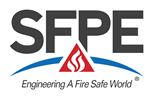Abstract
Ventilation cavities and gaps between material layers are common in modern construction. The cavities may provide a pathway for smoke and flame spread in the case of fire, more importantly, the narrowed space may lead to un-seeable, accelerated flame and smoke propagation due to the chimney effects. Therefore, the building regulation in the UK requests the provision of sufficient cavity barriers to close up and/or divide the cavities to control and mitigate the flame elongation and smoke propagation within the ventilated cladding system.
Perforated panels are increasingly used as cladding for buildings of all size and use. It provides a very effective way to enliven the façade. Perforated metal offers the same protection to a structure as other types of metal siding while allowing more effective pressure equalization between the space behind the panel and the exterior of the building. The chimney effect and thus the flame elongation behind the panel are different from these within the traditional ventilated render system. Therefore, it could lead to different need in the cavity barriers to prevent the flame and smoke movement within the cavities. Instead of physical testing, Computational Fluid Dynamic (CFD) modelling is used to investigate the fire-driven flow within the cavities behind the perforated panels with the intent to determine the requirements on the cavity barriers within the undivided cavity gaps.
PyroSim and FDS are utilized for the fire and smoke modelling. Flame height, thermal impact to the interior material surface and airflow velocities are predicted. The panels with different perforation rate are investigated under the same fire scenario with the purpose to provide guidance on the requirement of cavity barriers within external wall systems with perforated panel cladding.
Presentation
Resources
| Paper | Presentation | ||
|---|---|---|---|
| HTML | HTML | ||
| Resources Archive File (.zip) | |||


